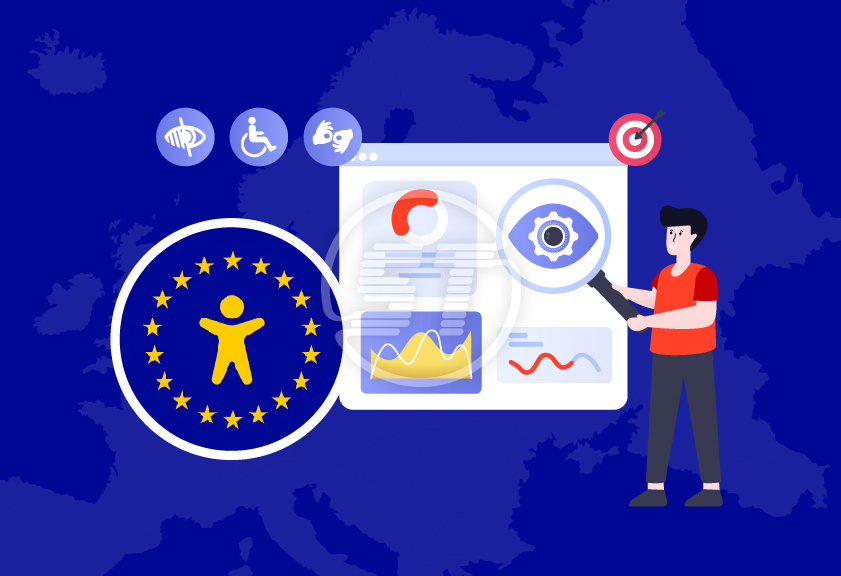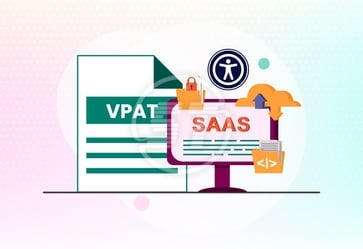The European Accessibility Act (EAA), is about to come in action from June 2025, mandates that digital products and services - including websites - should made accessible to people with disabilities. If a business operates in the EU or provides services to EU consumers, it is important that they ensure their website complies with the EAA guidelines. It will be a legal obligation is not just a best practice; it’s a legal necessity.
One of the most effective ways to ensure compliance is through a comprehensive website accessibility audit.
This article explains what an EAA-compliant audit involves and other details.
European Accessibility Act (EAA): Crucial information!
The EAA is a directive aimed at harmonizing accessibility requirements across EU member states. It covers a broad range of products and services, including:
- Websites and mobile apps
- Ecommerce platforms
- Banking services
- eBooks and eReaders
- Ticketing machines and self-service kiosks
The EAA is aligned with the Web Content Accessibility Guidelines (WCAG) 2.1 Level AA standards, which serve as the technical benchmark for digital accessibility compliance.
Website accessibility audit: what is it?
A website accessibility audit is a structured process to evaluate how well a website supports users with disabilities. It tests against WCAG 2.1 AA principles and checks compatibility with assistive technologies like screen readers and keyboard navigation.
For EAA compliance, an audit should not only cover technical accessibility but also ensure the site offers equal and usable access for people with various impairments (visual, auditory, motor, cognitive).
Who needs to conduct an accessibility audit?
The EAA applies to businesses providing digital services or selling products in the EU particularly:
- Ecommerce retailers
- Banks and financial institutions
- Publishers of eBooks
- Transport companies with digital ticketing
- Public and private sector organizations
If an organization fits into any of these categories and operates in the EU, it must audit its website for accessibility compliance.
Step-by-step guide to running an accessibility audit for EAA compliance
Step 1: Define the audit scope
Start by outlining:
- Key user journeys (e.g., browsing, checkout, contact forms)
- Devices and browsers to test
- Whether both the website and mobile app will be audited
- Language and regional versions if applicable
Step 2: Understand WCAG 2.1 AA guidelines
All the crucial team members must know the fundamentals of WCAG. The content should be weaved around its four important principles:
- Perceivable: Information must be presented in ways users can perceive (alt text for images).
- Operable: All interactive elements must be accessible by keyboard and assistive tech.
- Understandable: Content and navigation must be predictable and readable.
- Robust: Content must be compatible with a wide range of technologies.
Step 3: Use automated testing tools
Start with automated tools (e.g., Free Accessibility Checker) to identify issues like missing alt text, color contrast problems, keyboard traps, form labeling errors, and more.
Step 4: Conduct manual testing
Automated accessibility audit tools miss many critical issues, so human testing is essential.
Perform manual checks such as:
- Navigating using only a keyboard.
- Testing with screen readers (e.g., NVDA, JAWS, VoiceOver).
- Checking focus indicators and skip navigation links.
- Verifying accessible error messages on forms.
Step 5: Involve users with disabilities
If possible, recruit users with disabilities to perform real-world tasks on website. This uncovers usability and cognitive barriers that technical tests may not detect.
Step 6: Document accessibility issues
For each issue, record:
- A description of the problem
- Impacted user groups
- WCAG 2.1 success criterion violated
- Severity (critical, major, minor)
- Recommended fix
Use a structured format such as an Excel sheet or accessibility dashboard.
Step 7: Prioritize and fix
Work with the developers and designers to fix issues, prioritizing those that:
- Block access to critical services (e.g., payment, login)
- Affect multiple user groups
- Violate multiple WCAG guidelines
Ensure fixes are tested before deployment.
Step 8: Re-audit and validate
After remediation, run a second audit to confirm that:
- Issues have been resolved.
- No new problems have emerged.
- EAA-related user journeys are fully accessible.
Document the updated compliance status.
Accessibility audit tools and resources
| Tool | Purpose |
|---|---|
| Free Accessibility Checker | Website accessibility analysis via page URL |
| WAVE | Automated page analysis |
| axe DevTools | Chrome extension for devs |
| Siteimprove | Enterprise-level audit platform |
| NVDA / JAWS / VoiceOver | Screen reader testing |
| Lighthouse (Chrome) | General web performance and accessibility checks |
| Color contrast analyzer | For checking visual impairments |
Legal and compliance considerations
- The EAA allows national enforcement bodies to impose penalties and corrective actions for non-compliance.
- Businesses may be subject to fines, reputational damage, or being barred from tendering for public contracts.
- Keep audit documentation and evidence of improvements as part of the compliance record.
Best practices for ongoing EAA accessibility
- Incorporate accessibility in design and development workflows.
- Train staff on WCAG and inclusive design.
- Include accessibility testing in QA cycles.
- Review content uploads for alt text, captions, and readability.
- Appoint an Accessibility Officer or team.
Read another article on accessibility audit: Manual vs Automated vs Semi-Automated Accessibility Audits
In a nutshell,
The European Accessibility Act is not a one-time hurdle but a call to build inclusive digital experiences. A thorough website accessibility audit is the foundation for meeting the legal requirements and demonstrating the brand’s commitment to equity and inclusion. By combining automated scans, manual checks, and user feedback, the business can align with EAA standards and create a more usable web for everyone.
If you’re looking to meet European Accessibility Act (EAA) compliance, running a thorough website accessibility audit is your first step — and we are here to help! Our team provides reliable automated and manual accessibility audit tailored to European standards, including WCAG, EN 301 549, and national requirements for countries like Germany, France, Spain, and beyond. Let’s identify accessibility gaps, strengthen your digital presence, and create an inclusive online experience for all. Reach out hello@skynettechnologies.com or request a free quote!


